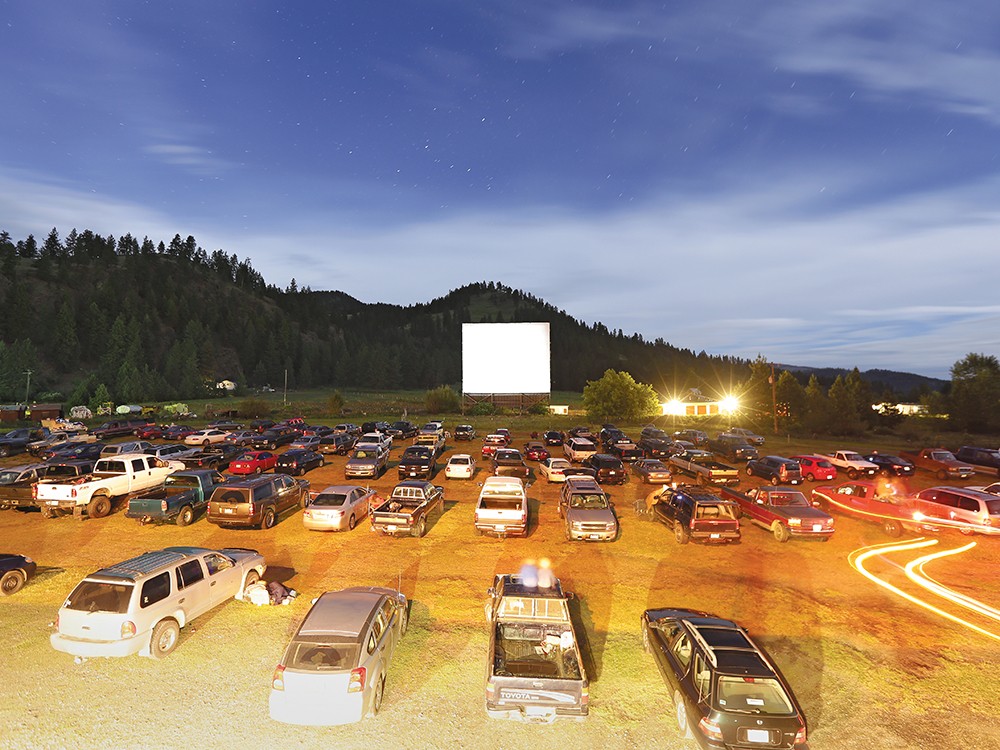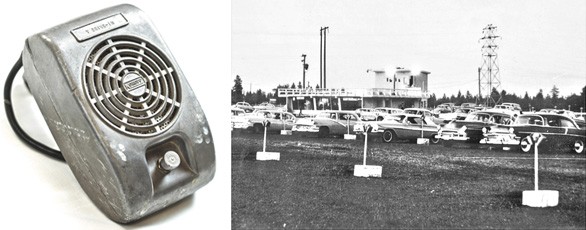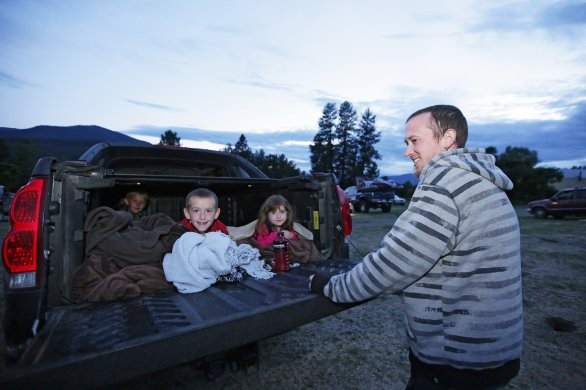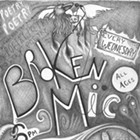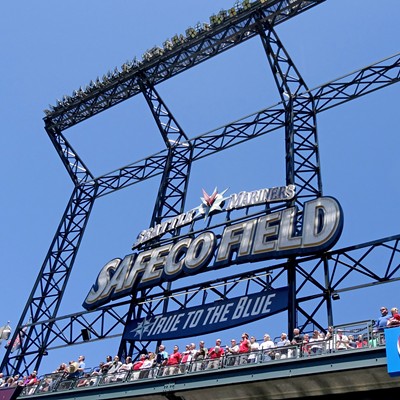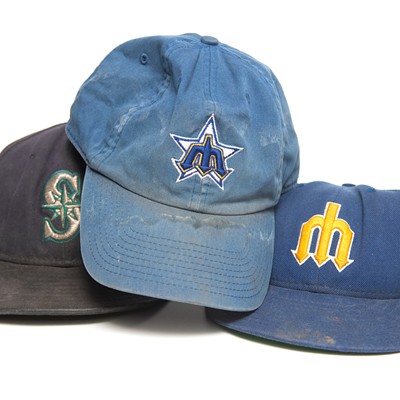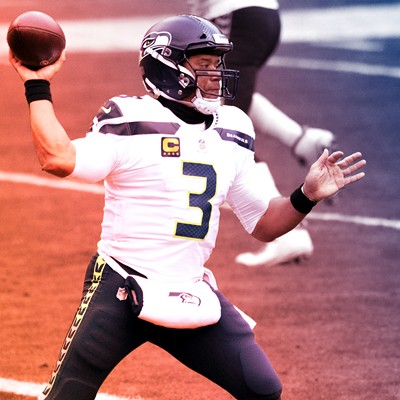The line has snaked its way onto Highway 395, slowing down what thin stream of Sunday evening traffic is coming in and out of Colville.
Soon, cars begin queueing up on the shoulder, waiting to turn onto a narrow country road. But rather than join the increasingly daunting line, two sedans, one after the other, charge off the side of the highway, through some waist-high weeds and into a gravel lot between the highway and the country road. Five teens hop out of the sedans. One of the guys has a couple pillows under his arm. A young girl has a blanket in one hand; the other waves to a white Chevy Suburban about a hundred yards down the way. All five jog to the SUV and proceed to bend the laws of physics, allowing all of them into the already crowded vehicle.
After more than a half hour of stopping and going, and stopping and getting out to run up to other teens piled into other massive vehicles, the improbably packed Suburban arrives at a building that looks exactly as old as it is. Here, a woman asks them for $14, because it’s a Sunday and that’s all it costs for a carload, no matter how many contorted extremities constitute that “carload.” A hand reaches out from a passenger window with exact change. Finally, the SUV rumbles into the Auto Vue Drive In, the last operational drive-in movie theater in Eastern Washington.
The gas-guzzler and its brave pilot find a vacant spot on the gopher-hole-pocked field, and just like other SUVs, trucks, station wagons and cars of all imaginable makes and models have been doing for 60 years, parks to watch — or with the intention to “watch” — two movies under a summer sky. But by this time next year, the rows of cars spilling forth with children and popcorn and lawn chairs and all the other Americana that comes along with that will be gone. This is the last season for the Auto Vue.
Technological advances in the theater industry have hammered the final nail into the coffin of a drive-in movie business that was first hampered by the advent of television, then home video rentals, then increasing property values, and all the while had to convince people that watching a movie through your windshield was a good idea.
Now, film distributors don’t want to ship prints of films, opting rather to send them digitally. This means theater owners like Steve Wisner, who was already running the Auto Vue on a razor-thin margin, would have to invest as much as $100,000 to convert to digital.
As the sky begins to slowly darken, despite it being past 9 pm, the assembled teenagers engage in the age-old game of Who Can Play Their Crappy Music The Loudest while younger kids sit impatiently in lawn chairs leaned up against bumpers of mini-vans, waiting for Fast & Furious 6 to appear on the weathered square of wood that serves as the Auto Vue’s screen. Two of those impatient (although perfectly well-behaved) kids are the nephews of Tammy Finley. She’s been coming to the Auto Vue for most of her life and brought the two boys — hard at work on a massive bucket of popcorn — over from nearby Inchelium on the Colville Indian Reservation to see a drive-in movie while they still could.
“There are a lot of people who are disappointed that it’s going away. When we were their age,” says Finley, pointing to the boys, “we’d run amok. The drive-in was just something you did growing up around here.”
Another guy says he had driven from northern Saskatchewan to visit family an hour or so across the border from Colville, and came down just to see an actual drive-in. Others memorialize the Auto Vue as though it’s an old friend who’s still on life support but is already being discussed in the past tense. They remember sneaking in and not getting caught. Or getting caught and having to face the music, which usually just meant paying for a ticket. No one seems to remember a particular film they saw here, but rather the fun — and often stupid — things they did at the Auto Vue. To many, it was an experience that went far beyond the screen.
Drive-in movies have been around in the U.S. since 1933, when the first theater opened in Camden, N.J. They were in the Inland Northwest by the late 1940s. Thanks in part to a car-obsessed culture after World War II, drive-in movies boomed to the point that there were almost 4,000 outdoor theaters operating nationwide, with seven in the greater Spokane area by the early 1970s. In Spokane, drive-ins could be impressive in scope. While Colville’s theater can hold around 200 cars, in the heyday of Spokane’s drive-in mania, several theaters could accommodate upwards of 700 vehicles.
A drive-in enthusiast could make his way through Spokane and not see strip malls or open fields or a piece of freeway, but rather the graveyards of long-forgotten, long-paved-over outdoor movie theaters. They’d look for a sign of the East Sprague Drive-In which remained open until 1993, but see only an I-90 interchange. They’d head up Division Street and look for the Autovue Drive-In but find only the remnants of a Lowe’s hardware store, which has since been relocated. Continuing north, they would remember the Y Drive-In, famous for its risqué selection of films, and realize that it was replaced by a car dealership some 30 years ago. Not far from there, near Whitworth University, was for many years after its demise a sign touting the North Cedar Drive-In. It’s just a stretch of housing now.
Even farther north, you’ll see what’s essentially a casket buried atop another casket. The Starlight Drive-In was leveled in favor of an indoor theater, the Newport Cinemas, but that, too, eventually became antiquated and has been serving as a canvas for graffiti artists since 2004. It was open for only 12 years — 1972 to 1984 — and had a reputation for showing horror flicks and other B-movies.
“Some of the movies we show are terrible, but our audience knows that and appreciates that,” said owner Walt Hefner in a 1981 Spokesman-Review article that already spoke of drive-ins as a gem of a bygone era.
Just west of Spokane, some might remember the West End Drive-In. When it opened in July of 1952, newspaper ads touted it as “The most modern new drive-in theater — many new features add to your pleasure and convenience.” It also closed in the early 1980s, leaving behind a concession stand to be beat up by vandals until recent years, when all traces were removed. On the far other end of town, the East Trent Drive-In is now nothing more than mixed industrial land.
Self-described “urban spelunker” Mike Corrigan, a former Inlander staff writer, remembers driving his parents’ Torino to Spokane’s drive-ins and watching as they fell by the wayside, one by one. The city grew, swallowing up the sort of open land required to run a drive-in theater. Part of the appeal of the drive-ins in Spokane was the fact that they were — and still are, if you can find them — cheap entertainment.
“It always appealed to young people and families with kids. It also appealed to people on dates who were there to make out,” says Corrigan, who tells a story about getting caught sneaking into the East Sprague Drive-In after hiding out in the trunk and having to borrow money from a young couple to keep from getting in too much trouble.
“It was a festive party atmosphere, for sure,” he says. “Half the fun was the people-watching.”
There’s a love for this place, but as the owner, Wisner can’t justify keeping it open. It’s a business before it’s a piece of nostalgia. To keep it open and operational, Wisner says it would require $175,000 for a new digital projector and a new screen. The current one was damaged in a 2007 windstorm and has been in danger of falling down ever since.
“It’s definitely the end of an era,” says Wisner, standing in the lobby of the Alpine Theater, the indoor theater he and his family also own. A line has formed at the box office in the minutes before Man of Steel is set to roll, and he’s handed off ticket-selling duties to his sister, Teri, so he can talk, albeit with plenty of sighs, about the drive-in.
Wisner came to Colville and began working in the theater business in 1974 when his father purchased the theaters. He’s seen the Auto Vue endure some ups and downs over those years. When video rental stores came about, the drive-in took a big hit. By the late ’80s his family was making more from a video store they owned than from the drive-in. While drive-ins around the country died off in droves during that time, the Auto Vue survived by switching to first-run movies and opening only on weekends, but there were other problems to deal with in recent years — vandalism, the aforementioned windstorm and a lawsuit with an insurance company over repairs to the screen.
But they’ve come to the end of the line, says Wisner.
“While we had the equipment out there, we were doing OK, but what we have out there is getting to the point that it’s falling apart,” says Wisner, adding that it wouldn’t make sense to replace their current 35mm projectors, given that film distribution companies won’t be sending out actual film reels of new films beginning next year.
When Wisner announced late last year that the drive-in would be closing, there was a surprising response from the community. Some said they should make it a historical landmark. Others said they should raise money to convert to digital.
“They want to do a fundraiser, but no one is going to give me $175,000, ever,” says Wisner.
On the other side of the state, though, there is a community that has managed to save its drive-in. When the Skyline Drive-In Theater in Shelton, a town northwest of Olympia on the westernmost finger of Puget Sound, was faced with either finding the funds to update its projector or close before this season, it turned to its supporters.
“There are so few drive-ins left that there are implications for this community beyond what’s merely financial,” says Christopher Mayes, whose mother Dorothea has been running the theater since 2005.
Christopher jumped in to help the business this winter after leaving a job in health care, putting together a Kickstarter campaign — an online entrepreneurial organization company — to fund, or at least partially fund, a new projector for the drive-in. They were only halfway to their goal of $40,000, with just a day left before — due to Kickstarter rules — they’d be out of time. But with just 18 hours remaining on the clock, they reached their goal, thanks in part to 512 donations ranging from $5 to several thousand dollars.
Mayes says they’ve raised the other half of the estimated $40,000 needed for a digital projector through other means and plan to go digital by the middle of this month, ensuring that in Shelton, at least, the drive-in will survive.
“They’re going to plant flowers here or something, I think,” says a high-school-age guy to his baseball-capped friend as they wait in line for refreshments in the waning moments before showtime.
“Maybe they could have people pay to come shoot gophers. There’s enough rednecks around here who would do that,” his friend says.
Their food order comes up, and the two wander through the maze of vehicles as previews begin to roll. People retreat to their driver’s seats or lawn chair or couch placed atop a pickup truck as Fast & Furious 6 fills up the warped screen in front of them. Gradually, the car stereos all tune into the close-range FM station that long ago replaced those clunky metal speakers, and it’s time to watch a movie. But it’s hard not to realize in the movie’s first few minutes that this is far from ideal, when big surround sound and stadium seating is the norm in indoor theaters these days. The shape of the screen, or the dust in the air, or maybe somebody’s headlights at one point makes it tough to distinguish which one of these guys is The Rock and which is Vin Diesel — not that it would necessarily matter to the plot of this meat-headed flick.
Soon, a pair of kids run past the rows of alternating hoods and rear bumpers, and it would be tough not to be distracted. Headlights flash on and off. Drivers move closer for a better view, kicking up some dust and muffling the sound of the movie. These sorts of things don’t happen at your local megaplex. There, you walk in, sit down and stare straight ahead for a couple hours. On this Sunday night at the Auto Vue, though, it feels like an event, not a movie. It’s something — at least until after Labor Day, when the last double feature hits the screen — to see, not just to watch.

